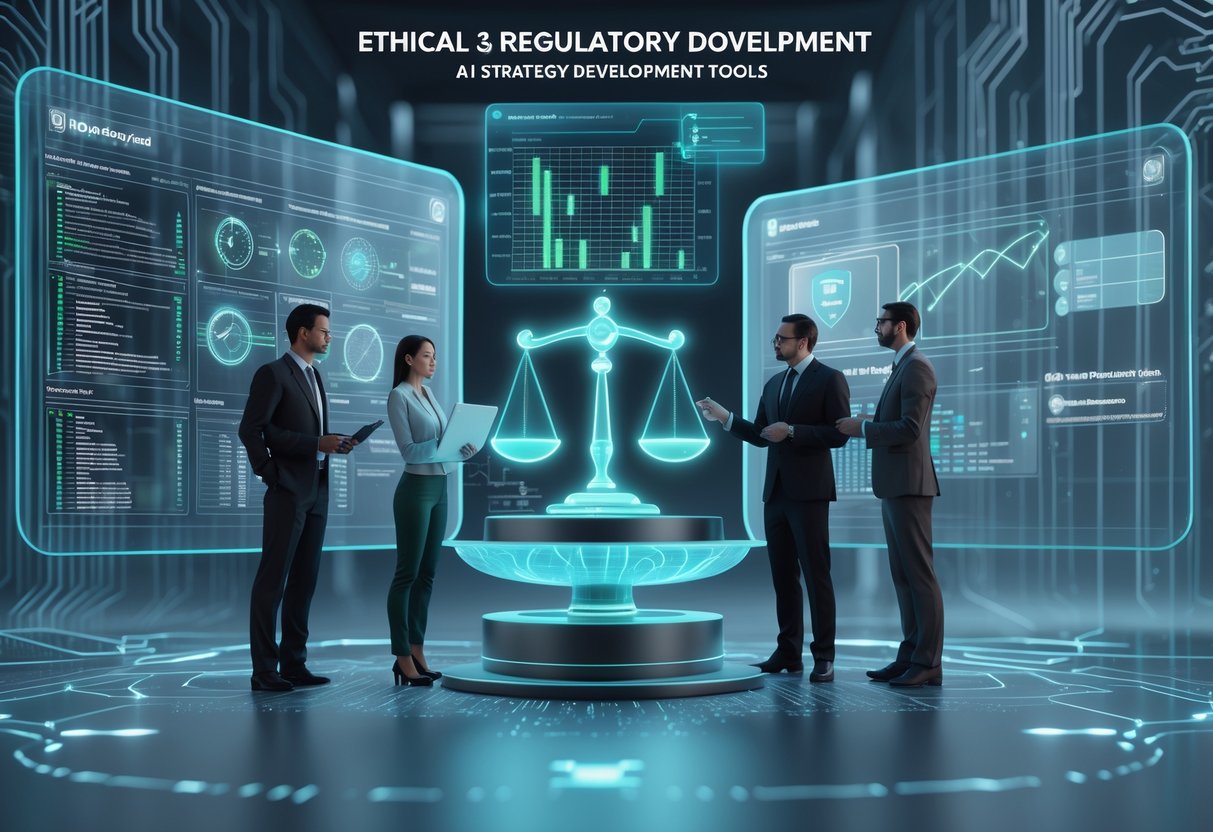AI Strategy Development Tools: Empowering Business Transformation
Updated On: November 13, 2025 by Aaron Connolly
Core Concepts of AI Strategy Development
AI strategy development blends artificial intelligence with traditional business planning. The goal is to create smarter, data-driven approaches that actually work in the real world.
When you understand the basics, you can build frameworks that connect AI capabilities directly to your business goals.
Definition of AI Strategy Development
AI strategy development means building a roadmap to weave artificial intelligence into everyday business operations and decisions. It’s not just about slapping AI tools onto old processes.
We focus on connecting AI technologies to specific business needs. That means figuring out where machine learning, automation, and data analytics can actually make a difference.
Key components include:
- Data infrastructure planning
- Choosing and implementing the right technology
- Training and skills development for your team
- Governance frameworks for ethical AI use
This strategy acts as a blueprint for transformation. It guides how you roll out AI across departments, keeping everyone focused on results you can actually measure.
Key Elements of Successful AI Strategies
Strong AI strategies always share a handful of core elements. These work together to cover both the technical and business sides of things.
The seven essential elements are:
| Element | Purpose | Key Focus |
|---|---|---|
| Principles | Ethical guidelines | Responsible AI development |
| Business Strategy | Commercial alignment | Revenue and growth targets |
| Governance | Risk management | Compliance and oversight |
| Operating Model | Process integration | Workflow optimisation |
| Talent | Skills development | Training and recruitment |
| Technology | Infrastructure | Tools and platforms |
| Activation | Implementation | Deployment and scaling |
You need to set up clear accountability for each area. Define roles, set milestones, and create feedback loops to track progress.
Quick win: Pick one element that tackles your biggest business headache and start there before expanding.
Difference Between Traditional and AI-Driven Strategic Planning
Traditional strategic planning leans on historical data and human analysis. People use past results to predict the future and rely on experience to guide decisions.
AI-driven strategic planning turns this on its head. Machine learning algorithms sift through massive amounts of real-time data, spotting patterns that people often miss.
Key differences include:
Traditional Planning:
- Monthly or quarterly reviews
- Manual data analysis
- Limited scenario planning
- Reactive decision-making
AI-Driven Planning:
- Ongoing monitoring and quick adjustments
- Automated insights
- Multiple scenario modelling
- Predictive recommendations
With AI strategies, you can move from reacting to predicting. You get the chance to spot market shifts, customer changes, and operational hiccups before they become problems.
Adaptation speed becomes a real edge. While traditional approaches might take weeks to notice a change, AI-powered systems can flag it in real time.
Types of AI Strategy Development Tools

AI strategy development tools usually fall into three main categories. Each plays a role in transforming strategic planning: predictive analytics platforms, natural language processing solutions, and machine learning algorithm platforms.
Predictive Analytics Platforms
Predictive analytics platforms use historical data to forecast what might happen next in the market or with your customers. These AI systems help you make smarter decisions by surfacing trends that aren’t obvious.
Most predictive analytics tools crunch sales data, market conditions, and customer interactions. They spit out forecasts for potential revenue, market share, and competitive position over time.
Key features include:
- Market trend forecasting
- Customer behaviour prediction
- Risk assessment models
- Scenario planning tools
Enterprise solutions can run £5,000 to £50,000 a year. Smaller teams often start with Tableau or Power BI for under £1,000 annually.
Heads up: Predictive analytics platforms need clean, organised data. If your data’s a mess, your forecasts will be too.
Natural Language Processing Solutions
Natural language processing (NLP) tools dig through text-based info like reports, customer feedback, and market research. These AI systems pull out insights from mountains of documents—stuff that would take people ages to read.
NLP solutions can scan thousands of documents in minutes. They quickly spot key themes, sentiment trends, and strategic opportunities buried in unstructured text.
Common uses:
- Competitor analysis from public documents
- Customer sentiment analysis
- Summarising industry reports
- Reviewing strategic documents
Prices range from £100/month for basic sentiment analysis to £10,000+ monthly for enterprise-level tools. Plenty of organisations start with free options like Google’s Natural Language API.
Machine Learning Algorithm Platforms
Machine learning platforms automate strategic decisions by learning from data. These tools help you optimise resources, set prices, and decide where to enter new markets.
ML algorithms get smarter as they process more data. They spot complex relationships that old-school analysis just can’t see.
Popular applications:
- Resource allocation optimisation
- Pricing strategy development
- Market segmentation analysis
- Investment prioritisation
Most platforms use subscription pricing starting at £500 a month. Custom enterprise solutions can hit £50,000+ per year, but the ROI can be huge if you use them right.
Quick win: Pick the platform that solves your toughest challenge first. You can always add more AI tools later.
Selecting the Right AI Tools for Strategic Planning
Choosing the right AI tools means matching what your business needs with what the tech can actually do. Your team’s readiness and how well different platforms perform in practice matter just as much.
Criteria for Tool Selection
Start with data integration capabilities. Look for platforms that connect to your existing systems—CRM, ERP, finance—without a ton of extra work.
Scalability is more important than cool features. You want tools that’ll grow with you, not ones you’ll ditch in a year or two. It’s easy to get dazzled by complex options when a simpler tool would be a better fit.
Ease of use can’t be overstated. If your team needs months of training, the tool probably isn’t right. The best ones feel intuitive within a week.
Cost structure varies a lot. Some charge per user, others by data volume. Don’t forget to include training, integration, and support costs when comparing.
Check for a proven track record in your industry. What works for retail might flop in manufacturing. Ask for real case studies.
Assessing Organisational Needs and Readiness
AI maturity is all over the map between companies. Be honest about your data quality, tech skills, and change management before you pick anything.
Start by checking your current data infrastructure. Messy data leads to bad AI results, no matter which tool you buy. Clean, organised data is non-negotiable.
Your team’s skills often matter more than the tool itself. Can your people interpret AI insights and use them in strategy? If not, upskilling might be in order.
Change management is a big deal. People might resist new processes or doubt AI at first. Plan for pushback and build confidence with small wins.
Budget goes beyond software. Add in data prep, training, and maybe consultant fees. Most teams underestimate these hidden costs.
Comparing Top AI Strategy Platforms
Enterprise platforms—think Microsoft’s AI tools—pack in features but need serious technical resources. They’re best for big companies with dedicated IT teams.
Mid-market solutions offer a balance of features and usability. They usually come with templates and guided workflows to speed things up.
Specialised tools zoom in on one thing, like scenario planning or risk analysis. They often play nicely with your existing strategy setup and require less training.
| Platform Type | Best For | Implementation Time | Typical Cost Range |
|---|---|---|---|
| Enterprise | Large organisations | 6-12 months | £50k-500k annually |
| Mid-market | Growing businesses | 2-4 months | £5k-50k annually |
| Specialised | Specific use cases | 2-8 weeks | £1k-15k annually |
Integration can be a headache or a breeze, depending on the platform. Some need heavy tech work, while others are plug-and-play.
Support quality really matters. When things go sideways, quick and helpful support can save your project.
Essential Features of AI Strategy Development Tools

The top AI strategy development tools all do three things well. They automate routine strategy work, turn complex data into clear visuals, and simulate different futures so you can test decisions before you commit.
Automation Capabilities
Automation sits at the heart of modern AI strategy tools. These platforms save you hours by generating strategic plans, building presentations, and updating roadmaps automatically as new data comes in.
Key automation functions:
- Creating strategic plans from raw data
- Auto competitor analysis and market research
- Real-time strategy updates as things change
- Automated resource allocation suggestions
Business automation with AI lets teams focus on big decisions, not endless data crunching. Some tools can pull together full strategy documents in minutes.
The tech spots patterns in market data and suggests pivots you might not see. This saves internal resources and cuts down on pricey consultants.
Advanced automation features learn from what worked (and what didn’t) in past strategies. They get better at making recommendations as you use them.
Data Visualisation and Dashboards
Good visual dashboards make mountains of data actually useful. These tools turn endless spreadsheets into charts, graphs, and interactive visuals that busy execs can understand fast.
Essential visualisation features:
- Real-time tracking of key metrics
- Interactive charts for market trends and forecasts
- Risk heat maps to spot problems early
- Dashboards to track strategy execution
Modern AI tools build visualisations that update automatically. Teams don’t have to waste time updating reports every week.
The best tools let you customise dashboards for different roles. Executives see big-picture summaries, while department heads get the nitty-gritty details.
Mobile-friendly dashboards let you check in from anywhere. Handy when you need to make a call on the go.
Scenario Planning and Simulations
Scenario planning tools let you test strategies before rolling them out. These platforms simulate market changes, competitor moves, and internal shifts to see how your plans might play out.
Core simulation features:
- Modelling different market conditions (recession, growth, disruption)
- Predicting competitor responses using past data
- Forecasting resource needs for each strategy
- Calculating risk across various scenarios
AI can run thousands of scenarios at once. This helps you spot weak spots in your strategy before they cost you.
These tools model everything from supply chain hiccups to new regulations. Planners get to prep for all sorts of what-ifs.
Simulations give confidence scores for each option. Teams can pick the strategy with the best chance of success—and have backup plans ready just in case.
Data Quality and Infrastructure Considerations

When you build AI tools for esports strategy, you need solid data foundations and strong security. These tech basics decide if your AI insights actually help teams win—or just create fancy guesses.
Data Governance and Management
Data quality can make or break AI strategy tools in esports. When match data is poor, player stats are missing, or tournament info is outdated, teams get bad recommendations—and that can cost them big.
We need to set up clear data governance frameworks that spell out who owns which datasets. Player performance metrics deserve stricter quality standards than, say, spectator engagement data.
Key data quality requirements include:
- Real-time match data accurate to the second
- Complete historical records covering several seasons
- Standardised player stats across tournaments
- Verified team composition and roster changes
Data infrastructure should include automated quality checks at every stage. Machine learning models can spot data quality issues before they mess up our AI results.
Let’s use adaptive data quality rules that change thresholds depending on how important the tournament is. Regular season matches might tolerate a bit of delay, but finals? Those need flawless data.
Metadata management gives our AI the context it needs. If we’re analysing player performance, the system must know map types, game modes, and patch versions—or else the comparisons don’t make sense.
Ensuring Data Privacy and Security
Data privacy is a huge deal when we’re handling player info, team strategies, and financial data. Esports organisations trust us with sensitive intel that could ruin their chances if it leaks.
We have to set up strict access controls and encrypt all player data. GDPR compliance means getting explicit consent before processing European players’ info, from match stats to behavioural analytics.
Security measures should include:
- End-to-end encryption for strategy talks
- Role-based access so only coaches and analysts see what they need
- Regular security audits of AI training datasets
- Secure deletion for data from retired players
Data retention policies need a careful balance. AI models work better with lots of history, but privacy laws demand we delete personal info on time.
We suggest federated learning where possible. Teams can learn from shared insights but keep their own strategies locked down on their servers.
Regular bias detection helps our AI avoid unfairly profiling players based on age, nationality, or other protected traits.
Strategic Use Cases for AI Tools

AI tools tackle three big areas where smart automation really matters. They boost customer satisfaction, lower operational costs, and spot risks before they explode.
Customer Experience Enhancement
AI changes the way we connect with customers by making interactions personal and support instant. Chatbots and virtual assistants answer basic questions around the clock, so human staff can focus on the tricky stuff.
Predictive analytics tools look at customer behaviour patterns and recommend things people might actually want. Netflix and Spotify do this all the time, suggesting content based on what you’ve watched or listened to.
Customer sentiment analysis keeps an eye on social media and reviews in real time. If customers get upset, we can catch it early and fix things before it blows up online.
AI-powered dynamic pricing tweaks prices based on demand, what competitors charge, and who the customer is. Airlines and hotels use this to squeeze out more revenue but stay competitive.
Voice recognition makes phone support less painful. Customers get routed to the right place without endless button pressing or repeating themselves.
Operational Efficiency Improvement
AI tools streamline operations by automating repetitive tasks and making resource allocation smarter. Predictive maintenance watches equipment health and schedules repairs before things break down.
Supply chain management gets sharper with AI forecasting. We can predict demand spikes, dodge stockouts, and avoid waste from overordering.
Automated document processing takes care of invoices, contracts, and forms without human hands. What used to take hours now takes minutes, with fewer errors.
Workforce scheduling AI matches staff shifts to predicted demand. Retail and restaurants use this to avoid being short-staffed when things get busy.
Quality control systems spot manufacturing defects faster than humans. They learn to catch problems that could lead to complaints or safety issues.
Process automation handles routine stuff like data entry, report generation, and email replies. That frees staff to focus on work that actually matters.
Risk Assessment and Management
AI helps us spot and stop threats across the business. Fraud detection systems scan transaction patterns in real time to flag suspicious activity.
Credit scoring models assess loan applications by looking at hundreds of data points. Banks use these to make quicker, fairer lending decisions.
Cybersecurity tools watch network traffic for odd behaviour. They can block attacks before hackers get in.
Market risk analysis uses AI to predict economic shifts that could impact business. Investment firms rely on these insights to manage portfolios.
Compliance monitoring makes sure we follow regulations automatically. That’s especially crucial in healthcare and finance, where mistakes are expensive.
Supply chain risk assessment flags vulnerable suppliers or routes. We can plan alternatives before disruptions mess up deliveries.
Integrating AI Tools into Business Strategy
Combining AI tools with business strategy takes a structured approach that covers both tech implementation and getting the organisation ready. The best integrations stick to clear planning steps and tackle obstacles before they trip up ai initiatives.
Steps for Successful AI Integration
Start by figuring out your business goals before picking any AI tools. It’s smarter to solve real problems than to chase tech for its own sake.
Define your objectives first. Set targets you can measure, like cutting customer service response times by 30% or boosting inventory accuracy by 25%. These goals keep you focused and help measure success.
Evaluate your data readiness. AI needs good data to work. Audit your sources, clean up inconsistencies, and make sure you’ve got enough info to train your models.
Pick tools that fit your needs. Decide if off-the-shelf solutions work or if you need something custom. Off-the-shelf is faster but less tailored.
Start with a pilot programme. Test your AI solution in a small, controlled setting. This way, you can spot issues and get feedback without disrupting everything.
Train your team well. Make sure staff know how to use the tools and what their limits are. People need to understand what the tech can—and can’t—do.
Overcoming Implementation Challenges
Most AI integration failures happen because of poor prep, not tech glitches. If you anticipate problems and build in solutions early, you’ll be in much better shape.
Tackle skill gaps early. Lots of businesses don’t realise how much expertise AI takes. You might need to hire specialists or bring in consultants.
Plan for compatibility issues. Your current IT setup might not play nice with new AI tools. Budget for possible upgrades or integration work.
Handle resistance to change. Employees often worry AI will take their jobs. Be transparent about how AI will help, not replace, people. Show them how it can make their work more interesting.
Keep an eye on performance. Set up tracking to measure AI against your original goals. Regular monitoring helps you catch problems early and proves ROI to stakeholders.
Get ready to scale. What works in a pilot might not hold up at full scale. Design your AI plans with growth in mind and test under real-world loads.
AI Roadmaps and Transformation Programmes
A clear AI roadmap helps organisations move from small experiments to full transformation. The trick is matching your approach to where you are on the AI journey, and tracking progress with the right metrics.
Building an AI Roadmap
We usually start by figuring out our AI maturity stage. Most companies fall into five buckets: exploring, planning, implementing, scaling, or realising value.
If you’re exploring, focus on learning about AI use cases and building basic know-how. Try out small pilots and see what sticks.
If you’re planning, pick use cases that line up with business goals. Map projects to outcomes like cutting costs or improving customer experience.
When you get to implementation, things get more technical. Implementation stage organisations need solid data infrastructure and the right cloud platforms to run AI models at scale.
Key roadmap components include:
- Timelines for each AI initiative
- Resource allocation plans
- Risk assessment frameworks
- Technology infrastructure needs
- Skills development programmes
Support from senior leadership makes or breaks AI success. Every organisation that’s realised real AI value has leaders who clearly back the effort.
Measuring Progress and Outcomes
We track AI transformation with metrics that change as we mature. Early on, we measure learning and capability building. Later, we focus on business impact.
Key progress indicators:
- Number of AI use cases in production
- Time from pilot to rollout
- Employee AI skills development
- Data quality improvements
- Return on AI investment
Early-stage companies usually look at efficiency and cost savings. More advanced ones care about growth, customer experience, and innovation.
Set baseline metrics before you start. Measure current performance in the areas you’re targeting for AI improvement.
Common mistakes? Focusing only on technical metrics or expecting instant results. AI transformation often takes 12-24 months to show big business impact.
Tracking works best when you align metrics with business goals, not just technical progress.
Ethical and Regulatory Aspects

AI strategy development tools have to tackle bias, fairness, and compliance challenges that shape competitive gaming and player experiences. These issues guide how esports organisations roll out AI responsibly.
Bias and Fairness in AI Tools
AI bias in esports strategy tools can create unfair advantages or even discriminatory outcomes. These tools crunch player performance, team composition, and match predictions using historical data—which often carries its own biases.
Common bias sources:
- Training data that favours certain play styles or regions
- Algorithms that disadvantage specific player groups
- Performance metrics ignoring diverse gaming approaches
We’ve seen bias pop up in matchmaking systems that favour certain strategies. Some AI coaching tools suggest tactics based mostly on data from male pros, which can overlook techniques used by underrepresented groups.
Fairness measures to put in place:
- Regular audits of AI recommendations for different player segments
- Diverse training datasets reflecting global gaming communities
- Transparent reports on how AI tools make decisions
Tournament organisers now often require AI bias checks before they approve strategy tools for competition. That helps keep play fair for everyone.
Compliance with Data Regulations
Data privacy laws have a big impact on how AI tools collect and use player info. GDPR in Europe and similar rules elsewhere tightly control how gaming companies handle personal data.
Key compliance requirements:
- Explicit consent for collecting gameplay and voice data
- Clear data retention policies for AI training
- Player rights to access, change, or delete their data
Data governance frameworks help esports organisations keep up with these rules. Automated compliance monitoring systems can track data use across AI tools.
A lot of AI platforms now offer built-in privacy controls. Players can limit data sharing but still use basic analytics. Some tools anonymise gameplay patterns before sending them to AI models.
Essential compliance steps:
- Regular audits of data collection
- Training staff on privacy laws
- Clear privacy policies about AI data use
- Secure, encrypted data storage
Gaming organisations face big fines for breaking these rules, so solid data governance isn’t optional—it’s a must.
Organisational Change Management for AI

Rolling out AI strategy tools takes careful planning for how your team will adapt. Helping your workforce embrace AI—and building the right culture—sets you up for long-term wins.
Managing Workforce Adaptation
Getting your team comfortable with AI tools really starts with some honest conversations about what’s changing and why. I’d suggest creating a simple “North Star” vision—make it clear that AI is here to make their jobs easier, not to push anyone out.
Most employees feel pretty anxious about job security when AI comes up. Tackle these worries head-on by showing real examples where AI takes over boring tasks and lets people focus on more creative work.
Training works best when it’s hands-on. Set up small pilot groups to try out AI tools first. Let these early adopters become your in-house champions who help train everyone else.
Try a three-phase approach:
- Phase 1: AI helps with specific tasks
- Phase 2: AI runs full workflows, but people still check the results
- Phase 3: AI fully automates routine work
Quick win: Start with teams that do repetitive work, like invoice processing or data entry. Early success here boosts confidence for bigger rollouts.
Change management works best when employees help design their own AI workflows, instead of just having new systems dumped on them.
Creating a Data-Driven Culture
To build trust in AI decisions, make sure you set up strong data governance right from the start. Your team should know where AI gets its info—and how to check if it’s actually right.
Set clear data access rules so everyone knows who can use what. Work with IT and legal to set guidelines for AI, especially if your team handles sensitive customer data.
Trust grows faster when you train AI on your company’s own documents, research, and procedures. That way, the results feel familiar and actually make sense to your team.
| Trust-Building Element | Action Required |
|---|---|
| Data transparency | Show sources for AI answers |
| Human oversight | Require approval for key decisions |
| Error handling | Create processes for fixing mistakes |
Warning: Don’t skip governance. Companies that rush into AI without proper oversight usually run into compliance headaches later.
Set up regular check-ins so teams can report issues or suggest improvements. This feedback loop helps you tweak AI tools and keeps people involved.
The strongest data cultures treat AI as a teammate, not just another piece of software.
Future Trends in AI Strategy Development Tools

The next wave of AI strategy tools is all about intelligent agents and personalized business applications. Companies are moving away from generic AI and instead want custom solutions that actually give them a competitive edge.
Emerging Technologies and Innovations
AI agents are quickly becoming the backbone of strategic planning. These advanced systems can now research competitors, analyze market data, and even simulate business scenarios—no human needed.
Some advanced AI capabilities we’re seeing:
- AI agents that scan millions of companies for merger targets in minutes
- Predictive models that spot market trends before they show up in sales data
- Simulation tools that test decisions across hundreds of scenarios
The business AI tools market is expected to hit £638 billion by 2025. That’s huge, and it shows that companies are moving past basic chatbots to specialized strategic assistants.
Gaming companies really benefit from these advances. AI tools now analyze player behavior to predict which game features will boost engagement. They also model what competitors might do when launching new titles or entering new markets.
Many organizations have reported 22% cost savings and 80% productivity gains after rolling out AI workflow tools. The tech takes care of research-heavy tasks, so strategists can focus on making decisions and getting things done.
Evolving Business Models
Strategy teams are now restructuring around AI-powered insights, not just traditional consulting. We’re noticing three big shifts in how businesses build strategic plans.
Proprietary data ecosystems are becoming a must-have. If you use generic AI inputs, you’ll get generic strategies. Smart organizations are building their own data networks to feed AI models unique information.
The subscription model for AI strategy tools is taking over. Teams can tap into advanced analysis for a monthly fee, instead of paying for big consulting projects.
Hybrid human-AI teams are the future. AI takes care of data crunching, scenario modeling, and research. Human strategists set the vision, manage stakeholders, and make bold decisions.
For gaming businesses, AI now monitors player sentiment, competitor launches, and market changes all the time. Strategy teams get alerts about major shifts and can adjust quickly instead of waiting for quarterly reviews.
Human judgment is still crucial for big-picture vision and gutsy decisions. But AI now provides the analytical backbone that makes those choices smarter and easier to defend.
Frequently Asked Questions

A lot of businesses are searching for straightforward answers about AI strategy development tools—from budget-friendly software to frameworks that actually work. Here are some practical answers about costs, implementation, and the solutions people actually use.
What are some cost-effective AI tools available for strategic planning?
You can find plenty of budget-friendly AI tools for strategic planning. Microsoft Power BI offers AI-powered analytics starting at £8 per user each month, while Google Analytics Intelligence gives free AI insights for website data.
Tableau Public lets you use basic AI visualization tools for free. Many small businesses start here, then upgrade later if they need more features.
For document analysis and planning, ChatGPT Plus costs £16 a month and helps draft strategy docs. Claude Pro does pretty much the same thing at the same price.
Open-source tools like Apache Spark are powerful and free, but you’ll need some technical know-how to get them running.
Can you outline an effective AI strategy framework for businesses?
A good AI strategy framework starts with setting your business goals before picking any tech. I’d suggest a six-step approach that works for a lot of companies.
First, check your current data quality and infrastructure. Bad data leads to bad AI, so don’t skip this part.
Second, look for specific use cases where AI solves real problems—think customer service automation or predictive maintenance, not flashy stuff that doesn’t help.
Third, review your team’s AI skills and training needs. Most teams need a lot of upskilling before they’re ready.
Fourth, set clear metrics for success. Pick things you can actually measure, like revenue, costs, or efficiency.
Fifth, create ethical guidelines and governance policies to prevent bias and regulatory headaches.
Sixth, plan for ongoing monitoring and improvement. AI systems need regular tweaks to keep working well.
Where might I find comprehensive guides on artificial intelligence strategies in PDF format?
Consulting firms often share detailed AI strategy guides as downloadable PDFs. McKinsey & Company posts free reports on AI implementation with practical frameworks.
PwC puts out annual AI analysis reports with industry-specific advice. Their “AI and Workforce Evolution” series has actionable tips for different sectors.
The MIT Technology Review releases quarterly AI strategy guides. These cover new trends and practical business applications.
Government sources like the UK’s Office for AI have comprehensive guides on responsible AI adoption. They address regulatory compliance and strategy.
Academic groups like Stanford’s HAI (Human-Centered AI Institute) share research-backed strategy docs. Their guides mix theory with real-world case studies.
Could you suggest automated solutions that aid in generating AI business strategies?
Several platforms now automate parts of AI strategy development. Palantir Foundry offers automated data analysis and strategy suggestions based on your company’s data.
IBM Watson Studio builds models and suggests strategies automatically. Their AI Planning Assistant reviews your business data and recommends relevant AI use cases.
Salesforce Einstein includes automated strategic recommendations right in their CRM. This is especially handy for sales and marketing teams.
H2O.ai has automated machine learning tools that spot strategic opportunities in your data and suggest AI applications.
DataRobot automates model selection and deployment. Their system checks your data and recommends effective AI approaches for your situation.
How is AI being integrated into strategy planning for companies today?
Most companies start with customer service chatbots and data analysis tools. These deliver quick wins and help teams learn what AI can do.
Manufacturers use AI for predictive maintenance and supply chain optimization. This cuts downtime and improves efficiency.
Retailers use AI for inventory management and personalized marketing. Amazon’s recommendation engine is still the classic example.
Financial services rely on AI for fraud detection and risk assessment. Banks are saving a lot with automated decision systems.
Healthcare organizations use AI for diagnostic support and patient flow optimization. This boosts outcomes and cuts admin work.
Professional services firms use AI for document analysis and client insights. Legal and consulting teams especially value contract analysis and research automation.
What are the best AI applications currently recommended by leading consulting firms for strategic planning?
Most top consulting firms usually start by pointing to data analytics and visualization tools. Tableau, Power BI, and Qlik Sense come up again and again when you ask about strategic insights.
When it comes to process automation, you’ll probably hear them mention Microsoft Power Platform or UiPath. These tools can handle routine planning work like gathering data or cranking out reports.
AI-powered CRM tools are also getting a lot of love. Salesforce Einstein and HubSpot’s AI features let teams dig into customer behavior in ways that just weren’t possible before.
For predictive analytics, SAS and IBM SPSS seem to get a lot of nods. Companies use them to get a handle on where the market might be heading and how their business could perform.
Financial planning software with AI perks is another big one. Adaptive Insights and Anaplan help teams automate budgeting and play out different scenarios—super useful when you need to make fast decisions.
Natural language processing tools are also making waves for document analysis. They let planners sift through piles of market research and competitive intel way faster than before.

